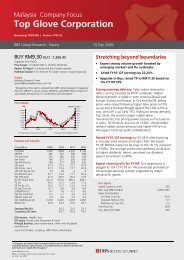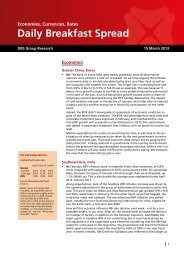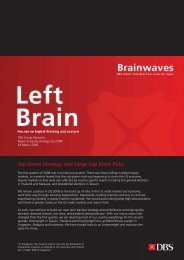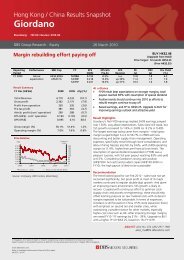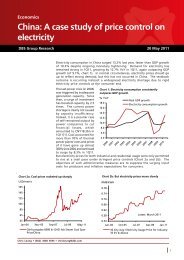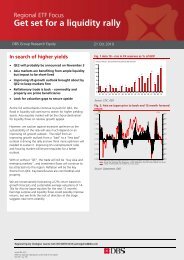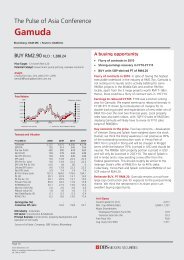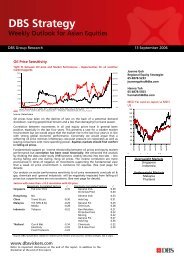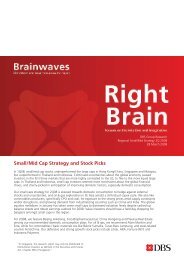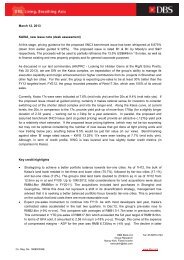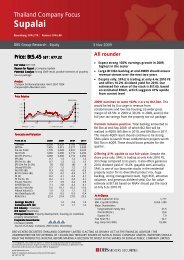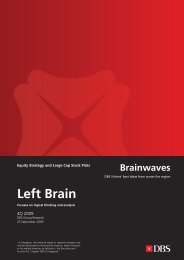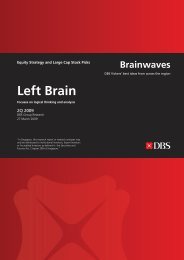Economics Markets Strategy - the DBS Vickers Securities Equities ...
Economics Markets Strategy - the DBS Vickers Securities Equities ...
Economics Markets Strategy - the DBS Vickers Securities Equities ...
Create successful ePaper yourself
Turn your PDF publications into a flip-book with our unique Google optimized e-Paper software.
<strong>Economics</strong> – <strong>Markets</strong> – <strong>Strategy</strong><br />
Currencies<br />
Euro – relinquishing its anti-USD role<br />
The high of 1.6018 achieved by EUR/USD on Apr 22 is likely to be <strong>the</strong> peak for<br />
<strong>the</strong> next 6-12 months. Looking ahead, <strong>the</strong> EUR is set to lose its anti-USD role on<br />
expectations for <strong>the</strong> EU-US interest rate differentials to narrow, as well as a<br />
policy shift in G7’s exchange rate stance towards discouraging USD weakness.<br />
In our opinion, <strong>the</strong> EUR/USD’s rally during <strong>the</strong> US mortgage/credit crisis from Jul<br />
2007 to Apr 2008 did not reflect a strong EUR view, but a weak USD view driven<br />
by aggressive US rate cuts amidst steady EU rates. Between Sep 2007 and Apr<br />
2008, <strong>the</strong> Fed Funds Rate (FFR) fell from 5.25% to 2.00%, or half <strong>the</strong> ECB’s 4.00%<br />
refi rate.<br />
Looking ahead, we expect EU-US interest rate differentials to narrow, as <strong>the</strong>y<br />
always do after Eurozone loses its GDP growth advantage to <strong>the</strong> US. The Fed<br />
should start taking back rate cuts in 4Q08, initially as an exercise to normalize<br />
interest rates. The FFR is expected to rise to 4.50% by 3Q09 and reclaim its<br />
positive carry against <strong>the</strong> EUR. This is not an unreasonable prospect considering<br />
that US real interest rates, whe<strong>the</strong>r measured against headline CPI or core inflation,<br />
are significantly lower than <strong>the</strong>ir EU counterparts.<br />
There was also a major shift in <strong>the</strong> G7’s stance on exchange rates in 2Q08. At its<br />
meeting in April, G7 nations warned that sharp fluctuations in major currencies<br />
could threaten economic and financial stability. After EUR/USD rose above 1.50,<br />
Eurozone officials persisently complained about <strong>the</strong> EUR’s overvaluation and<br />
<strong>the</strong> USD’s undervaluation.<br />
Lending support here is <strong>the</strong> US-EU trade deficit, which is set to narrow for <strong>the</strong><br />
third straight year in 2008 to below USD100bn for <strong>the</strong> first time since 2003.<br />
Eurozone also reported a current account deficit of EUR17.8bn in 1Q08, its worst<br />
level since 2Q01. If this persist, it will be <strong>the</strong> first since 2001 that Eurozone<br />
posted a current account deficit.<br />
EUR/USD<br />
forecast, eop<br />
Latest Prev<br />
Close 1.56 1.55<br />
2Q08 1.55 1.48<br />
3Q08 1.52 1.50<br />
4Q08 1.49 1.54<br />
1Q09 1.46 1.50<br />
2Q09 1.43 1.49<br />
3Q09 1.45 1.48<br />
4Q09 1.46 1.48<br />
ECB refi rate<br />
forecast, eop<br />
Latest Prev<br />
Close 4.00 4.00<br />
2Q08 4.00 4.00<br />
3Q08 4.25 4.00<br />
4Q08 4.25 4.00<br />
1Q09 4.25 4.00<br />
2Q09 4.25 4.00<br />
3Q09 4.25 4.00<br />
4Q09 4.25 4.00<br />
Latest close on Jun 11<br />
Prev close on Mar 12<br />
These initial currency complaints by EU officials initially fell on deaf ears, that is<br />
until <strong>the</strong> US Treasury and <strong>the</strong> Fed acknowledged in June that <strong>the</strong> weak USD was<br />
responsible for fueling inflationary expectations by boosting commodity prices,<br />
especially food and energy prices. Given that EUR accounts for 57.6% of <strong>the</strong><br />
weight in <strong>the</strong> <strong>the</strong> DXY (USD) index, this implies that <strong>the</strong> firmer USD sought by<br />
G7 to rein in commodity prices will inadvertently imply a weaker EUR.<br />
During <strong>the</strong> US rate hike cycle in 2005, EUR/USD returned close to 40% of its<br />
three-year rally from 2002 to 2004. If history repeats itself in <strong>the</strong> coming US<br />
tightening cycle, EUR/USD has potential to fall back towards 1.43 by mid-2009.<br />
EU-US policy rate spread to fall with GDP spread<br />
2<br />
1<br />
0<br />
-1<br />
-2<br />
-3<br />
EU-US<br />
GDP growth<br />
spread, % YoY<br />
EU-US<br />
policy rate<br />
spread, % pa<br />
96 97 98 99 00 01 02 03 04 05 06 07 08<br />
G7 seeks a firmer USD (or weaker EUR) should pull<br />
down commodity prices<br />
440<br />
420<br />
400<br />
380<br />
360<br />
340<br />
320<br />
300<br />
280<br />
260<br />
CRB index<br />
(lhs)<br />
Jan-07 Jul-07 Jan-08<br />
EUR/USD<br />
(rhs)<br />
1.65<br />
1.60<br />
1.55<br />
1.50<br />
1.45<br />
1.40<br />
1.35<br />
1.30<br />
1.25<br />
29



